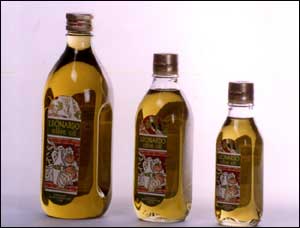
Okay, so you used olive oil in one of your best Indian recipes, and to your
shock, the taste itself changed. And to think that olive oil is said a good
cooking medium! For some reason, when the whole world turned to olive oil, no
one told us Indians which variety to use for our kind of cooking. Everyone
thought we should use Extra Virgin olive oil because it was supposed to be the
best. Best flavour, sure, but not the best for Indian cuisine.
Olive
Oil And Indian Cooking
Olive
pomace oil is the cooking grade oil used all over the Mediterranean for every
type of cooking. This oil can be used for all methods, types and varieties of
Indian cooking; it neither changes in taste nor presents any difficulties while
cooking. Indian cuisine, whether fried, roasted or cooked by any other method,
tastes as good with olive pomace oil as with sunflower, safflower, corn or any
other oil. Being low priced, it provides optimum value for money as the best
cooking grade oil for Indian cuisine.
Cooking
With Olive Pomace Oil
• While
frying foods between 130ºC and 190ºC, this oil forms a crisp, golden
crust, making fried food much more appetising, without affecting its nutritional
value.
• During
the frying process, the oil hardly penetrates the food, leaving it light and
digestible.
• This
oil does not break down, provided the temperature does not exceed 190ºC.
• That
it is expensive is a misconception. Though olive pomace oil costs more than
other edible oils, it is economical to use since food can be cooked in 1/3rd the
quantity of other edible oils. Since it has a high smoking point, it can also
be reused three to four times as long as it is filtered carefully after each use
through gauze, muslin or a suitable paper filter. Considering these two points,
the effective cost of olive oil is 1/6th its actual price!
Tips
For Users
• While
dressing salads, pour the olive oil in first and then add salt and vinegar or
lemon. Adding the oil first provides a protective layer, which helps the
vegetables to stay fresh and crisp.
• Olive
oil is excellent to spread on meat being barbecued, as it helps to preserve the
natural juices.
• Any
meat, fish, or vegetable fried in olive oil is tastier, as the oil prevents the
food from sticking and becoming greasy.
• Meat
marinated in olive oil before cooking will be much tastier. As olive oil is very
delicate, it helps the aromatic herbs and spices to mix.
• To
enjoy a delicious snack, spread a little garlic on toast and then add some olive
oil.
• If
you use a little olive oil in the water when cooking pasta, it will prevent it
from sticking.
• Ingredients
should be dried before deep-frying for best results. Make sure that the frying
pan contains enough olive oil to cover the ingredients. If there is too little,
food will be too soft or will burn.
• Olive
oil in the pan should be hot but not smoking when the food is immersed for
frying.
The
Three Varieties
Extra
Virgin (EV) Olive Oil
• The
highest grade olive oil with perfect aroma and flavour.
• Results
from the first cold pressing of the olive fruit within 24 hours of harvesting.
• Relatively
heavy and viscous and suitable only for dressing, flavourings and condiments.
• Used
to dress salads, pastas, rice, vegetables, meat and fish.
Pure
Olive Oil
• A
combination of refined olive oil and extra virgin olive oil. Refined olive oil
is obtained by refining oil that does not possess optimum characteristics.
After
refining, the oil is blended with EV olive oil.
• Intermediate
grade oil with medium aroma and flavour and a paler colour.
• Suitable
for pan and deep-frying, stir-fries, sautés and stews. In cakes and
pastries, it is used both as ingredient in dough and also for frying but it is
not suitable for cooking Indian cuisine.
Olive
Pomace Oil
• The
main cooking grade oil.
• Obtained
by treating the olive residue paste (after the fruit has been pressed) with
solvents to extract the oil and then blending this product with EV oil in order
to enhance the product.
• Light
oil with neutral taste and flavour.
• Suitable
for Indian cuisine. The least expensive olive oil.

Chef Kaviraj Khialani throws light on why olive oil isn't popular with Indian
kitchens
Cost:
Olive oil proves expensive if incorporated into our daily diet. An average
bottle of olive oil works out to not less than Rs 500 for a litre. Not everyone
is really comfortable with investing so much money on olive oil when they can
buy five litres of any other oil at about the same cost.
Typical
Tastes: Gourmets suggest that the taste of certain typical Indian food solely
depends on the oil. For eg, 'sarson ka saag' would lose its original taste, if
not for the mustard oil. Similarly, 'makki ki roti' wouldn't be what it is,
without the pure ghee or white butter. This is true with several typically
Indian dishes! Most people do not like to substitute their regular oil with
olive oil, despite the proven health benefits.
Matching
Flavours And Palates: Chefs at restaurants find it tough to meet guests'
expectations in experimenting with the oil, for fear of being rejected by the
guests.
Awareness:
Indians find it difficult to get accustomed to olive oil in their daily diets,
mainly because olive oil does have a peculiar aroma, which overpowers certain
dishes. But, of course, this viewpoint will soon change with the entry of
certain varieties of extra light olive oils.
(Source:
ASOLIVA)
V
N Dalmia is the Chairman of Dalmia Continental Pvt Ltd and Dalmia Tourism
Services Pvt Ltd. He has conducted a series of research studies in olive
oil.



